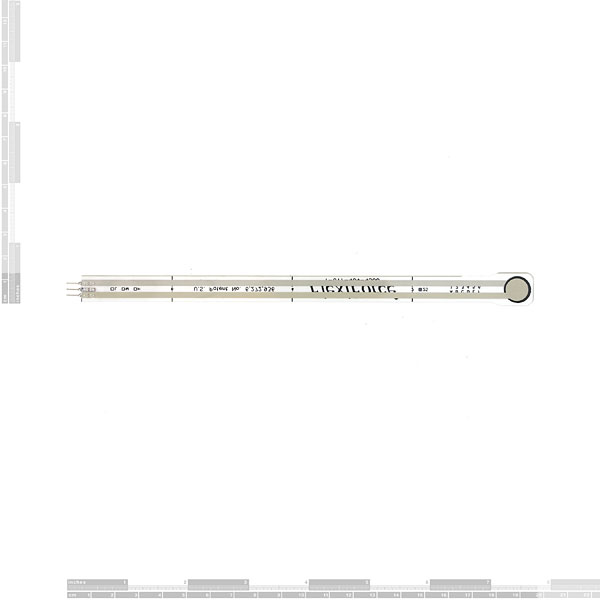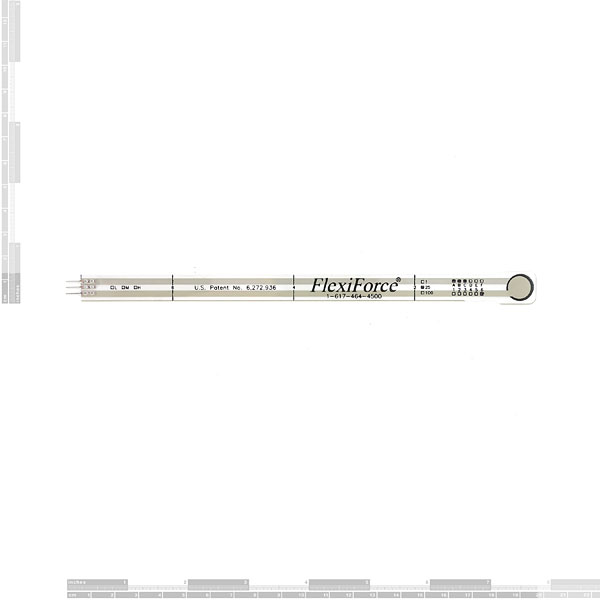FlexiForce Pressure Sensor - 1lb.
This is a piezoresistive force sensor from Tekscan. The harder you press, the lower the sensor's resistance. Pressing lightly, the resistance changes from infinite to ~300k. The sensor itself is thin and flexible, but the resistance does not change while being flexed. Resistance changes only when pressure is applied to the round area at the end of the sensor. Used as a presence sensor (someone standing), weight sensor, pressure sensor (impact testing), etc.
The overall length is about 8.5". Sensor comes with 0.1" spaced, reinforced, breadboard friendly connector.
This sensor comes in three flavors. This sensor ranges from 0 to 1lb of pressure.
FlexiForce Pressure Sensor - 1lb. Product Help and Resources
Force Sensitive Resistor Hookup Guide
May 5, 2016
How to hook a force-sensitive resistor up to an Arduino to measure pressure variances.
Calibration
For information on how to calibrate your sensor go here => http://www.tekscan.com/how-do-i-calibrate-my-flexiforce-sensor.
Core Skill: Electrical Prototyping
If it requires power, you need to know how much, what all the pins do, and how to hook it up. You may need to reference datasheets, schematics, and know the ins and outs of electronics.
Skill Level: Noob - You don't need to reference a datasheet, but you will need to know basic power requirements.
See all skill levels
Comments
Looking for answers to technical questions?
We welcome your comments and suggestions below. However, if you are looking for solutions to technical questions please see our Technical Assistance page.
Customer Reviews
No reviews yet.




Is there another version of this without the long flex area? Can it be cut and new leads created?
Would this be sensitive enough to sense an envelope?
Hey all, I made a guide on setting this up and calibrating it with an op amp and Arduino. The data is accurate, and it gives about 0.5 gram resolution on this sensor. http://www.seraphdrone.com/blog/flexiforce-pressure-sensor-with-arduino
Is it accurate to measure 0-0.2 newton? And how to relate the output with force? Any Idea?
It doesn't do very well at little to no load, but you can pre-load it. If there is already 0.5lb on it, it will read 0.5-0.55 lb very accurately. Just subtract the 0.5lb to get the reading you're interested in.
T - What about drift in this scenario? According to their documents drift is "<5% per logarithmic time scale (constant load of 90% sensor rating)". Would we need to then calibrate the device constantly as long as the pre-load is applied?
Would this be able to sensor force less than 10gram? It is for a medical application that I'm looking for a sensitive one at very low pressure
I want to measure the force being applied to a cable (imagine an old fashioned tug-o-war). Is there a mechanical way for one of these to do that? Is there a different product that would do the job better?
I just received a few of these and had problems getting any data out of them at a force in the lower 5% of the range of the sensor. I connected it to the advertised OpAmp circuit and cranked up the gain, but nothing. No change in resistance at low forces. I called Tekscan (the manufacturer) and Dan, an engineer, explained that they do not work at a force less than 0.05lb. I'm not sure about any of their higher force models, but watch out for low ranges!
~Rich
Are these water proof (below the connector of course)? Could I use one to measure the depth of water in a tank?
The sensors are only water-resistant, not waterproof. If you wanted to use these under water, you would need to completely seal the sensor (cover it entirely) with a sealant (one without acetic acid) or protect it with a poly bag.
is there an example circuit?
Late reply, but hopefully helpful to others;
The sensor wants to be run through an op amp, look through the datasheet for example circuits.